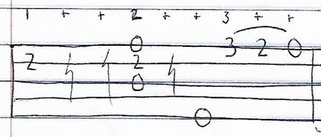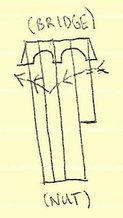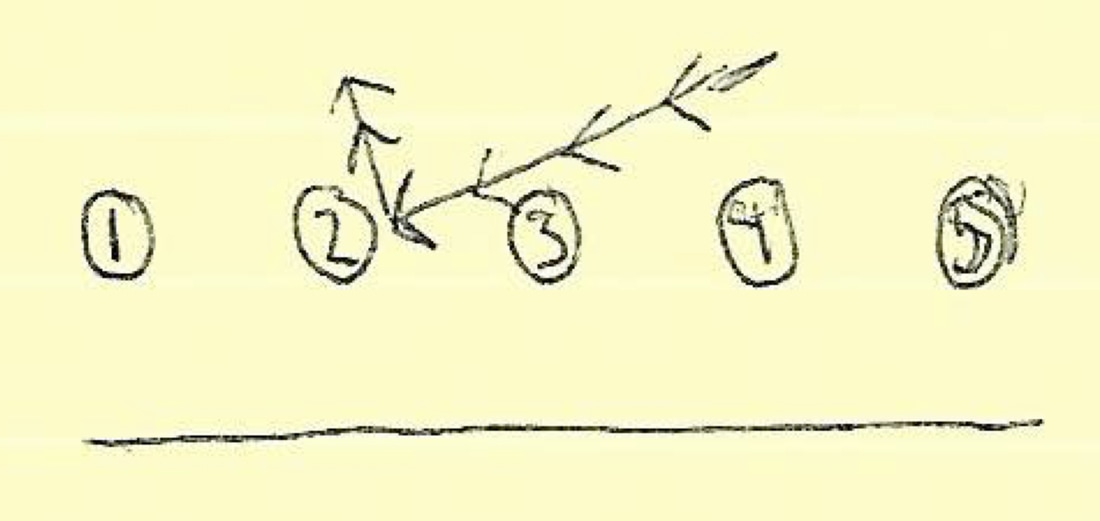|
This week's post is the 3rd installment of a series of blogposts on playing Waltzes on Clawhammer banjo. In the 1st post (here), I talked about "straight rhythm" waltzes. In the 2nd post (here), I talked about the more-common-to-Old-Time "swing rhythm" waltzes, in which the beats are subdivided into groups of three rather than two. In both of those posts, I leaned pretty heavily on the Christmas tune "The First Noel" as an acessible example of a Waltz which could be played either way (i.e. either with "straight" or "swing" rhythm). If you haven't read these posts yet, I'd encourage you to go back and glance through them first to give this wee's post some context.
In this week's post, I'm doing a 3rd installment on playing waltzes on clawhammer banjo, in which I'll talk a bit about "breaking right hand stride" (post on right hand stride here) in waltz playing. As an example tune, I'll veer away from the holidays and back towards a relatively recent addition to the Old Time canon, "Swannanoah Waltz," which was written by the fiddler Rayna Gellert, and which I learned for a recent squaredance (here). For those unfamiliar with Rayna Gellert's playing, she is (in my opinion) the unquestioned master of putting "groove" into Old Time fiddling... I guess I'll start by providing a tab of "Swannanoah Waltz," give a bit of an overview on my approach to playing it, then spend some time picking apart a particularly nasty section that shows up in the B part:
Note on the above tab - if you look closely at the B part you'll see evidence of me digitally correcting a mistake (...poorly...) at the end of the second line. Sadly, trying to get ther resulting corrected file down to a reasonable size prior to uploading it turned out to be so taxing on my computer skills that if I make a mistake in the future, I'll likely just rewrite and rescan a new tab : )
Overview of playing "Swannanoah Waltz": First, this is a D major tune and, as indicated on the tab, I play it in double D tuning (aDADE)....no surprises there. It is also a swing rhythm waltz, meaning that notes, such 5th string as thumb pulls, are delayed a bit to give a "swingy" feel. As I explained in last week's post (once again, here) this is accomplished first by subdividing beats into groups of 3 rather than groups of 2, thereby creating a "one, and, and, two, and, and, three, and, and" (rather than a "one, and, two, and, three, and") pattern to each measure; notes are only played on beats or on the second "and" beat; the first "and" beat after each beat is generally left empty. Real quick, lets look at a couple tab examples of "straight rhythm" and "swing rhythm" waltzes to hit home what I'm talking about:
Figure 1 (last weeks Figure 2) - A "bum-ditty-ditty" rhythm for straight ryhthm waltz playing.
Figure 2 (last weeks Figure 4) - A "bum-diiiiitty-diiiiitty" rhythm for swing ryhthm waltz playing.
If you're still a bit confused about the difference between Figures 1 and 2, check out the audio examples of "The First Noel" in last week's post (again, here). So, all of that was to say that, because "Swannanoah Waltz" is a swing rhythm waltz, the beats are divided into threes. Becuase I always explicitly indicate beat above each tab I write, you'll see the "1 + + 2 + + 3 + +" rhythmic indications similar to FIgure 2 above the tab for "Swannanoah Waltz" (rather than the "1 + 2 + 3 +" rhythmic indications).
As discussed last week, swing rhythm waltzes may include notes on both "and" beats following a single beat, which can be difficult to negotiate without breaking stride. "Swannanoah waltz" (as I've written it) only includes one instance where both "and" beats are occupied. This occurs in the 7th measure of the A part:
FIgure 3 - The 7th measure of the A part of "Swannanoah Waltz."
(from the tab at the top of the page).
While both "and" beats following beat 3 are filled with notes, we can get them all with a series of pulloffs from a single pluck with the striking finger - no "stride breaking" necessary in this instance . However, I did promise that we'd break stride somewhere in the tune....lets dig in!
Breaking Right Hand Stride in "Swannanoah Waltz" I've covered right hand stride in several posts (here and here) and even re-introduced my rules governing right hand stride in a waltz context (here and here). I guess it behooves me to put them up one more time for reference: ---------------------------- Rule 1 for maintaining right hand stride: The striking finger of the right hand moves towards the strings on every beat; the thumb never plays notes on the beat. Rule 2 for maintaining right hand stride: The striking finger is never used to play notes between beats; these notes should be played with the thumb of the right hand, with a left hand pluck, or by hammer-ons/pull-offs from notes played on preceding beats. Rule 2a) if the note on an "and" beat is on a lower string than the preceding note (or if the preceding beat contains a brush, cluck, or ghost note) this note should be played with the thumb of the right hand, or by plucking the string with the left hand. Rule 2b) if the note on an "and" beat is at a higher fret of the same string of the preceding note, this note should be played with a hammer on. Rule 2c) if the note on an "and" beat is at a lower fret of the same string of the preceding note, this note should be played with a pull off. Rule 2d) if the note on an "and" beat is on a higher string than the preceding note, this note should be played by plucking the string with the left hand. ----------------------------- Though I developed these rules in the context of playing 4/4 tunes, straight rhythm waltz playing can easily be accomplished by following these rules as well; swing rhythm waltzes need not break rules either, as long as only one "and" beat following each beat is occupied with a note. As we've seen in Figure 3, right hand stride can even be maintained in the face of notes on both "and" beats in a swing rhythm waltz with some careful tricks (like two consecutive pulloffs from one pluck with the striking finger). As I've mentioned before (here), there are times when right hand stride must be broken out of necessity. In the tab for "Swannanoah Waltz," I've actually chosen to break stride in the 7th measure of the B part as a stylistic choice. Let's take a look at the offending phrase without any markups to indicate right hand maneuvering:
Figure 4 - A phrase from the B part of "Swannanoah Waltz" without any indications of how to play it.
As written, this phrase would be a bit difficult to play without breaking right hand stride. This is mostly due to the note on the second "and" beat following the first beat of the measure (which I'll refer to as the "1 + +" beat). Since this note occurs on a higher string than the note prodceeding it on beat 1, we could follow rule 2d above and play it with a left hand pluck thereby maintaining right hand stride. Here's what I'm talking about, (with the rest of the phrase filled in "in stride" for good measure):
Figure 5 - Using a left hand pluck to play a phrase from "Swannanoah Waltz" while maintaining right hand stride.
However, left had plucks are much more easily accomplished on open strings; in the case of what's shown in Figure 5, you'd have to simultaneously hold down the 3rd fret with your middle finger (assuming you're using the left hand position indicated in the tab - click here if you dont know what I'm talking about) and pluck the string with the ring or pinky finger of your left hand. These are acrobatics I'd prefer to avoid : ). We could move the two notes on the 1st string over to the 2nd string and get everything with hammer-ons and pull-offs, while maintaining right hand stride:
Figure 6 - Shifting notes onto the 2nd string to maintain right hand stide.
As you can see, the approach shown in Figure 6 allows you to match the fiddle on every note without the inconvenient left hand pluck shown in Figure 5, and because you can cover the 5th fret with your pinky, you dont even have to shift left hand position to get there! So why don't I play it this way? To look at the answer, let's go back to the initial phrase, and point out a couple notes:
Figure 7 - A phrase from "Swannanoah Waltz" with "strong notes" circled.
When you listen to Rayna Gellert play this tune, you'll notice that the notes I've circled above are given just a bit more "umph" than the other notes in the phrase. To my ear, Rayna Gellert's aforementioned "groove" is at least partly ascribable to her emphasis of off beat notes (i.e. syncopation). If we play what's written in Figure 6, the "strong" notes circled above are played as a hammer-on and a pull-off respectively....when played this way, these notes sound weaker than those that proceed them in my hands. In other words, by playing this way, we are in danger of losing the "groove."
So how to fix this? To me, the "strongest" sounding notes made by a clawhammer player are those played with the striking finger (though left hand plucks can be pretty strong as well). Therefore, I choose to break right hand stride and use the striking finger to play the notes circled in FIgure 7 as follows:
Figure 8 - Breaking stride to play a phrase from "Swannanoah Waltz." The notes with asterices above them are meant to be played with the striking finger even though they occur on "and" beats.
Below I explicitly break down whats going on here. I'll just stick to the notes within the offending measure (once again, measure 7 of the B part in the tab at the top of the page) since the "lead in" notes and the notes in the following measure are actually played in stride.
Description of what's going on in Figure 8 (bold lines indicate stride breaking moves): ----------- Beat 1: Striking Finger (Rule 1) Beat 1+: (empty) Beat 1 + +: Striking Finger (violation of Rule 1) Beat 2: Pull off (violation of Rule 1 in that striking finger should play on beat notes) Beat 2 +: (empty) Beat 2 + +: Striking Finger (violation of Rule 1) Beat 3: drop thumb (violation of Rule 1) Beat 3 +: (empty) Beat 3 + +: Hammer-on As you can see, Figure 8 does involve playing two notes in a row with the striking finger (those on beat 1 and beat 1 + +)...though you do get a bit of a "grace beat" in between them due to the extra "and" beats associated with swing rhythm playing. As a review: two quick consecutive notes can be played with the striking finger in a single motion as long as the second note is on the next higher string up from the first. You simply have to aim your strike of the first string so that you end up resting on the next string, then lift your hand up while continuing forward motion to get the next note as follows:
Figure 9 - A poorly drawn explanation of how to play two notes with the index finger on adjacent strings in quick succession (this originally appeared as Figure 8 in my second post on right hand stride here). For the figure on the left, pretend you're looking down your banjo neck from the nut to the bridge...and that every part of the banjo other than the strings and bridge has disappeared for some reason. For the figure on the right, the circled numbers represent cross-sections of strings 1-5 and the line at the bottom represents the fingerboard.
I'd encourage you to try both FIgure 6 and Figure 8 and see if you can hear the difference. In my opinion, while you may not naturally accentuate the desired strong notes (i.e. those circled in Figure 7) by playing what's written in Figure 8, breaking stride in the ways indicated by FIgure 8 makes it easier to alter your playing to accentuate those notes.
After all that, I think its time to hear this thing!
Me playing the tab of "Swannanoah Waltz" that you can find at the top of this page on my Buckeye in aDADE tuning. To be perfectly honest, I think I could have played this better (...gets kinda laggy in the B part...) but I had already put away the microphone before noticing....so I left it as is : )
Hope that this third Waltz installment brought it all together for you - feel free to let me know your thoughts in the comments!
-------------------------------- A sad note to end this post: This past week we lost Cory, the bass player from my former band, in a tragic accident. Cory was far from just a bandmate and musical partner - I really feel like I've lost a family member. A couple years back (when I was still living in VA and gigging with the band), we decided that we'd start putting any profits from gigs towards hosting pig roasts to which all of our friends were invited. Cory (an Engineer by trade) couldn't help but take the reins in the cooking department and while watching him manage (and iterativly improve upon) the primitive cinder block contraption we built for roasting a whole pig, I knew I was to truly seeing a guy "in his element." Those pig roasts were some of the happiest memories I have of Cory - over time attendance swelled as most of his extended family started making the trek down to VA from the Midwest every time we had one. To all of Cory's family and friends: know that I'm grieving with you from my spot in Michigan.
4 Comments
3/26/2018 03:56:02 am
The third chapter has been more exciting to read from the time that I have got to read this one on this blog. The updated version has been more exciting to read from the one that has been released so far.
Reply
4/23/2018 12:29:28 am
Clawhammer Waltzes part 3 series really amazing as well as part one and two with many new things. part 3 is literally going very much better than the previous parts by my opinion.
Reply
9/21/2020 02:16:15 am
Get the best services of the antivirus and secure your devices from the hackers. Apply the best saving deal on the best Kaspersky antivirus software and save maximum bucks on the security of your devices and private information.
Reply
Leave a Reply. |
-----
|










 RSS Feed
RSS Feed